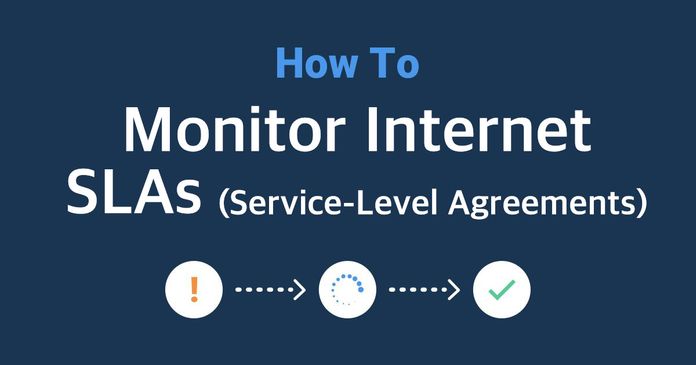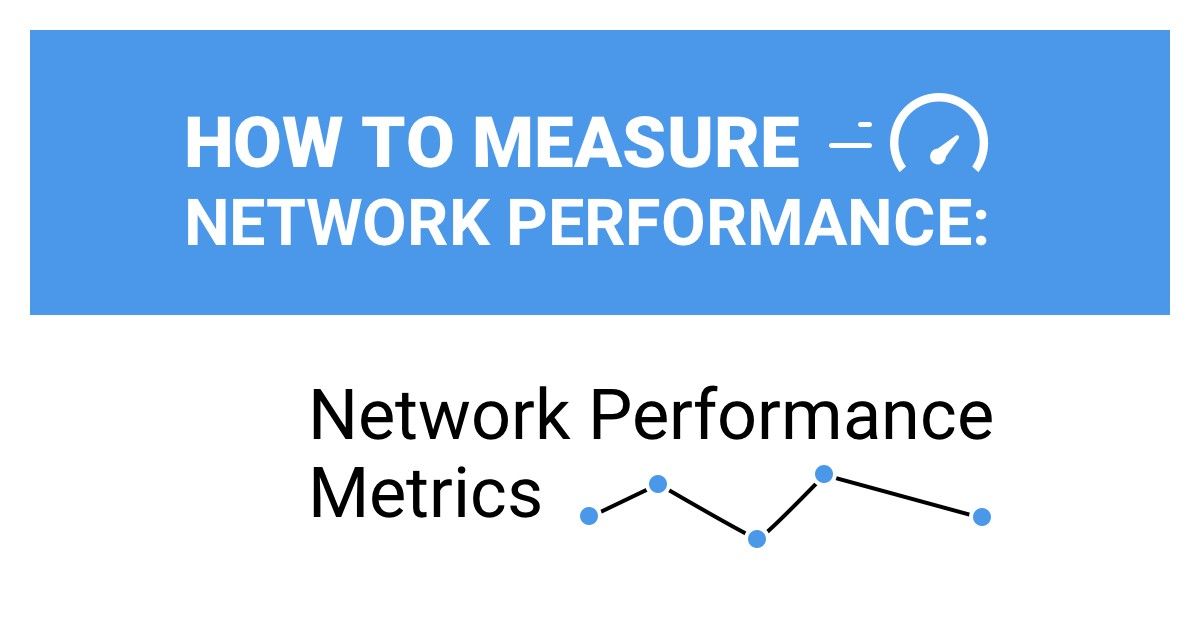Table of Contents
Table of Contents
Have you ever felt like you're stuck in a slow internet vortex, where your favorite cat videos take forever to load? Or maybe you've heard people throwing around terms like 'network speed,' 'bandwidth,' and 'throughput' but have no idea what they actually mean.
Well, fear not! In this blog post, we're going to dive into the wild world of networking and unravel the mysteries of network speed, bandwidth, and throughput.
Network bandwidth, network speed, and network throughput are often used interchangeably in the world of networking, but they are not the same thing. While all the terms refer to the amount of data that can be transmitted over a network, they are measured in different ways and serve different purposes.
- Network Speed, which is the most commonly spoken about metric when it comes to network and application performance, refers to the speed at which data is transferred between two devices on a network.
- Network Bandwidth refers to the maximum amount of data that can be transmitted over a network or communication channel in a given period of time.
- Throughput refers to the actual amount of data that is transmitted over a network or communication channel in a given period of time.
Understanding the difference between network speed, bandwidth and throughput is important for network administrators and anyone involved in managing or troubleshooting network performance issues.
In this article, we will explore the differences between network speed, network bandwidth and network throughput, and how they are measured, to help you better understand how to optimize and troubleshoot network performance.
Network performance metrics like network speed, bandwidth and throughput are all essential to measuring and monitoring your network performance. So you need a tool that can monitor them all!
You don’t have to choose - monitor all network metrics!

- 14-day free trial of all premium features
- Deploy in just 10 minutes
- Monitor performance in all key network locations
- Measure real-time network metrics
- Identify and troubleshoot live network problems

Network speed, also known as data transfer rate, refers to the speed at which data is transferred between two devices on a network. It is usually measured in bits per second (bps) or bytes per second (Bps). Network speed can vary depending on the type of network, the devices used, and the distance between them.
In simple terms, network speed is how fast data travels from one device to another over a network. A higher network speed means that data can be transferred more quickly, resulting in faster downloads, uploads, and overall internet browsing speeds.
We always hear people talk about speed when referring to network performance. Mainly because speed is one of the easiest network metrics to understand.
But when it comes to monitoring network speed, it’s important to measure network speed with an end-to-end Network Monitoring solution that also measures other key network metrics, like latency, packet loss, throughput, jitter, to give you full visibility of the actual performance of your network.

When discussing network performance monitoring, the metric that we most commonly hear about is Network Speed. But in the network world as in life, speed isn't everything, quality matters too.
That being said, measuring network speed can still be important for several reasons:
- Performance Optimization: Monitoring network speed helps you identify performance bottlenecks and optimize the network for maximum speed and efficiency. By understanding the current speed of your network, you can identify areas that need improvement, such as upgrading hardware or optimizing software settings.
- User Experience: A slow network can lead to a poor user experience, resulting in frustration and decreased productivity. By monitoring network speed, you can ensure that your users have a fast and reliable network connection, which can improve their overall experience.
- Cost Optimization: Monitoring network speed can help you optimize your network costs. By understanding the speed of your network, you can identify areas where you may be overspending on unnecessary bandwidth or hardware upgrades. This can help you save money and improve the overall efficiency of your network.
Overall, monitoring network speed is important for ensuring optimal performance, user experience, network security, and cost optimization.
There are several methods to measure network speed, and the choice of method depends on the type of network and the desired level of accuracy.
Here are some common methods for measuring network speed:
- Speed Test Websites: This is a simple and easy-to-use method that can provide a quick estimate of your network speed. Speed test websites like Speedtest.net, Fast.com, or Google Speed Test allow you to check your network's download and upload speeds by sending and receiving data packets to and from a server.
- Network Performance Monitoring Tools: There are several network performance monitoring tools available that can provide detailed insights into network speed and other performance metrics. These tools can monitor network traffic, identify performance bottlenecks, and provide real-time network monitoring alerts when performance issues arise.
- Command Line Tools: Command line tools like Ping, Traceroute, and IPERF are commonly used to measure network speed and performance. These tools send packets of data between devices and measure the time it takes for the packets to travel back and forth, providing a measure of network latency and throughput.
- Network Traffic Analysis: Network traffic analysis tools can be used to capture and analyze network traffic, providing insights into network speed, packet loss, and other performance metrics. These tools can help identify performance issues and optimize network configurations to improve speed and efficiency.

It's crucial to use an end-to-end Network Monitoring and Network Speed Monitoring tool for monitoring network speed, as well as Internet speed. That's because, a complete NPM tool, like Obkio, measures not only network speed, but also other important network metrics such as packet loss, jitter, and latency. By measuring these metrics, you can achieve complete visibility over the quality of your network.
To measure network speed with Obkio network performance monitoring, you can follow these steps:
- Create an account to start Obkio's Free 14-Day Trial
- Deploy Network Monitoring Agents in key network locations where you want to measure network speed and network performance. This can include offices, data centers, clouds, and so on.
- Create a new Network Device in your Obkio account.
- Choose the "Network Speed Testing" option for the device.
- Select the remote test agents that you want to use to test the network speed.
- Configure the testing settings, including the testing interval and the network monitoring protocol to use for the testing.
- Save the changes and start the network speed testing.
Once you have set up the network speed testing, Obkio will begin testing the network speed between the selected devices at the specified interval. You can view the results of the speed tests in real-time on the Obkio Dashboard, and also access historical data to analyze trends in network speed over time.
To analyze the network speed data, you can use the various charts and graphs available in the Obkio Dashboard, including line charts, bar charts, and pie charts. You can also set up alerts to be notified when network speed drops below certain thresholds, which can help you quickly identify and resolve network performance issues.
Bandwidth refers to the maximum amount of data that can be transmitted over a network connection in a given period of time. It is typically measured in bits per second (bps) or bytes per second (Bps). For example, a network connection with a bandwidth of 100 Mbps can transmit 100 million bits of data per second.
Think of network bandwidth as the width of a pipe that carries water. Just as a wider pipe can carry more water at once, a higher network bandwidth can transmit more data at once. However, if there are too many devices using the network at once, or if the network's physical capacity is limited, the available bandwidth will be divided among the devices, which can result in slower network speeds and longer download times.
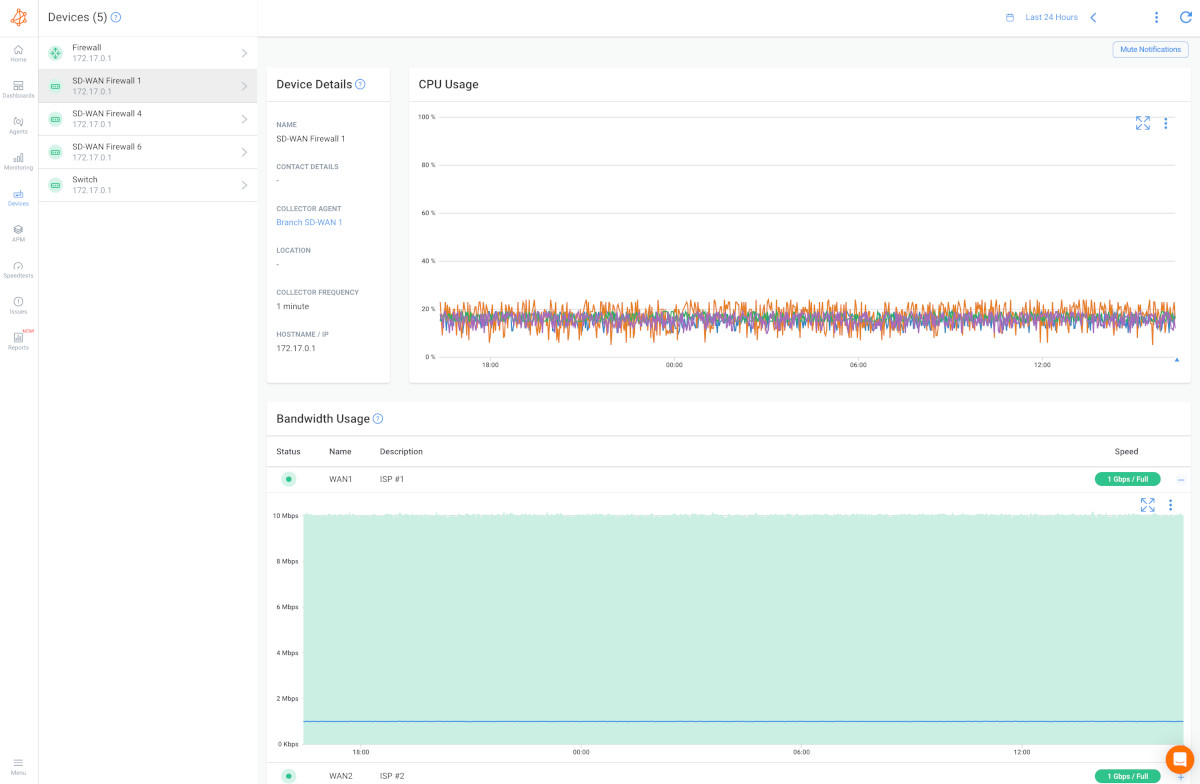
Network bandwidth is an important metric that plays a critical role in network performance, user experience, scalability, and business operations. It is important to ensure that the network has sufficient bandwidth to support current and future needs, while also monitoring and optimizing bandwidth usage to control costs.
Here are some reasons why measuring network bandwidth is important:
- Network Performance: Bandwidth plays a crucial role in network performance. The higher the bandwidth, the faster the data can be transferred over the network, resulting in better performance and faster load times for applications and websites.
- User Experience: A network with high bandwidth can provide a better user experience, particularly for bandwidth-intensive applications such as video streaming or online gaming. Users can enjoy faster load times, smoother playback, and fewer interruptions or buffering.
- Scalability: Bandwidth is a critical factor in network scalability. As more users or devices are added to the network, the demand for bandwidth increases. If the bandwidth is not sufficient to handle the increased demand, the network can become slow and unresponsive.
- Business Operations: Many businesses rely on high-bandwidth networks to support their day-to-day operations. For example, businesses that rely on cloud-based applications, file sharing, or video conferencing need a network with high bandwidth to ensure smooth and efficient operations.
- Cost Optimization: Network bandwidth can be a significant expense for businesses, particularly those with high-bandwidth requirements. Monitoring and optimizing bandwidth usage can help businesses control costs and avoid unnecessary expenses.
In general, measuring bandwidth involves transferring data and measuring the time it takes to complete the transfer. The method you choose will depend on your level of technical expertise, the tools available to you, and the specific needs of your network.
There are several ways to measure bandwidth, including:
- Speed Test Websites: There are many free online tools that allow you to test your internet speed and measure your bandwidth. These websites typically work by downloading and uploading files of varying sizes and measuring the time it takes to complete the transfers.
- Network Performance Monitoring Software: You can use network performance monitoring software, like Obkio, to monitor your network bandwidth usage and overall network performance. These tools can provide real-time and historical data on your network bandwidth usage, as well as identify bottlenecks and other issues.
- Command-Line Tools: You can use tools like iperf or speedtest-cli to measure your bandwidth. These tools allow you to test your bandwidth between two devices on a network.
- Network Hardware: Some network hardware, like routers and switches, have built-in tools for measuring bandwidth. These tools may allow you to view real-time and historical data on your network usage, as well as configure quality of service (QoS) policies to prioritize certain types of traffic.
Measuring bandwidth with an end-to-end Network Performance Monitoring tool, like Obkio, is the best way to get a complete overview of your network performance at large. Measure bandwidth, as well as other aspects in your network that can impact your bandwidth usage.
To measure bandwidth with Obkio network performance monitoring, you can follow these steps from our Bandwidth Monitoring page.

Once you have set up the bandwidth monitoring, Obkio will begin collecting data on the amount of data being transmitted and received through the selected interfaces. You can view this data in real-time on the Obkio Dashboard, and also access historical data to analyze trends in bandwidth usage over time.
To analyze the bandwidth data, you can use the various charts and graphs available in the Obkio Dashboard, including line charts, bar charts, and pie charts. You can also set up alerts to be notified when bandwidth usage exceeds certain thresholds, which can help you quickly identify and resolve network performance issues.
Theoretical bandwidth and actual bandwidth describe two aspects of your network’s capacity. While theoretical bandwidth represents the maximum potential data transfer rate, actual bandwidth reflects real-world performance.
Think of theoretical bandwidth as the top speed of a sports car on a perfect, empty highway. Actual bandwidth, however, is how fast you can drive during rush hour with stoplights, traffic, and potholes.
Theoretical Bandwidth is the maximum data transfer rate that a network connection can achieve under ideal conditions.
- Based on lab testing or simulations.
- Assumes no interference, congestion, or inefficiencies.
- Rarely achieved in real-world conditions.
Measuring Theoretical Bandwidth:
- Often specified by your Internet Service Provider (ISP) or network hardware manufacturer, typically in Mbps (megabits per second) or Gbps (gigabits per second).
- Example: A Wi-Fi router rated for 1 Gbps offers a theoretical bandwidth of 1000 Mbps.
Actual Bandwidth is the real data transfer rate experienced by users during everyday network use.
- Reflects the true performance of your network.
- Affected by factors like latency, packet loss, and hardware quality.
- Varies based on network load, time of day, and usage patterns.
Measuring Actual Bandwidth:
- Often lower than theoretical bandwidth due to real-world constraints like interference, congestion, or hardware limitations.
- Example: On a 1 Gbps connection, your actual bandwidth might be 600 Mbps due to simultaneous device usage and network overhead.
Why Actual Bandwidth Falls Short of Theoretical Bandwidth
- Network Overheads: Protocols like TCP/IP add headers and control information, reducing usable data capacity.
- Interference: In Wi-Fi networks, physical obstacles, other devices, and competing signals degrade performance.
- Congestion: Multiple users or devices sharing the network can cause bottlenecks.
- Hardware Limitations: Routers, switches, and cables may not fully support the theoretical bandwidth.
- ISP Constraints: Your ISP may throttle speeds during peak hours or enforce limits.
- Distance: On wired and wireless networks, greater distances can reduce data transfer efficiency.
Theoretical bandwidth sets expectations, while actual bandwidth reveals reality. Understanding the difference helps you identify performance bottlenecks and optimize your network for better efficiency.
How to measure bandwidth, identify issues & optimize network performance. Use Obkio's Network Performance Monitoring tool for easy bandwidth monitoring.
Learn more

Finally, we’ve reached network throughput. Throughput refers to the actual amount of data that is successfully transmitted over a network connection in a given period of time. It is also measured in bits per second or bytes per second. The throughput of a network connection can be affected by a number of factors, including network congestion, packet loss, and network latency.
Internet throughput, often referred to simply as "throughput" or "internet speed," is a measure of the rate at which data is transmitted over an internet connection. It quantifies the amount of data that can be sent or received in a given period, typically expressed in bits per second (bps), kilobits per second (Kbps), megabits per second (Mbps), or gigabits per second (Gbps).
Internet throughput is a crucial metric for assessing the performance and quality of an internet connection. It directly impacts how quickly data can be downloaded from or uploaded to the internet. Higher throughput means faster data transfer speeds, while lower throughput results in slower speeds.
Measuring network throughput is essential for ensuring the performance of your network infrastructure and allows you to understand how much data actually made it across your network.
Here are some reasons why measuring network bandwidth is important:
- Performance Optimization: Monitoring network throughput helps identify networks bottlenecks and other performance issues. By analyzing network traffic, you can identify which applications or processes are using the most bandwidth and optimize them accordingly. This can help improve network performance and reduce latency.
- Network Troubleshooting: When network issues occur, monitoring network throughput can help identify the root cause of the problem. By analyzing network traffic, you can identify which devices or applications are causing the issue and take appropriate action to resolve it.
- Capacity Planning: Monitoring network throughput helps you plan for future capacity needs. By analyzing network usage patterns over time, you can predict when you'll need to add more bandwidth or upgrade network infrastructure to accommodate increased traffic.
- Security: Monitoring network throughput helps detect and prevent network security threats. By monitoring traffic, you can detect suspicious activity such as attempts to access unauthorized resources or large amounts of data being transferred to unknown destinations. This can help you identify and respond to security threats before they cause damage.
- Compliance: Many industries have regulations that require companies to monitor network traffic for compliance purposes. For example, financial institutions must monitor network traffic to ensure compliance with regulations such as the Payment Card Industry Data Security Standard (PCI DSS).
Several factors influence throughput for your network or Internet performance, including:
- Bandwidth: The amount of data that can be transmitted over the Internet connection simultaneously. It is often determined by the Internet service plan you subscribe to and is typically measured in Mbps.
- Network Congestion: The level of network traffic on your Internet service provider's (ISP) network can affect throughput. During peak usage times, network congestion may lead to reduced throughput.
- Physical Distance: The physical distance between your location and the server or resource you are accessing can impact latency and, consequently, throughput. Longer distances may result in higher latency and reduced throughput.
- Network Quality: The quality of the network infrastructure, including the reliability of routers, switches, and cables, can influence throughput. Poorly maintained or outdated equipment may limit throughput.
- Internet Service Plan: The type of Internet service plan you subscribe to, such as DSL, cable, fiber-optic, or satellite, can significantly affect your available throughput. Fiber-optic connections, for example, often offer higher throughput compared to DSL.
- Network Traffic Management: Some ISPs may implement traffic management policies that prioritize certain types of traffic, affecting throughput for specific applications or services.
- Network Protocol: Different internet protocols, such as TCP (Transmission Control Protocol) and UDP (User Datagram Protocol), can impact how data is transmitted and may influence throughput under certain conditions.

Measuring network throughput is important to ensure that the network is functioning properly and to identify any potential performance issues. In general, measuring throughput involves transferring data and measuring the amount of data transferred over a given period of time.
Here are some ways to measure network throughput:
- Network Performance Monitoring Software: Network performance monitoring software like Obkio, can measure the throughput of your network over time. These tools provide real-time and historical data on network performance and can help identify trends and potential network issues related to throughput.
- Network Testing Tools: There are various network testing tools available that can measure the throughput of your network. One popular tool is iPerf, which can be used to measure both TCP and UDP throughput.
- Packet Capture Analysis: Packet capture analysis tools capture and analyze network traffic, which can be used to calculate the actual throughput. By analyzing the packet capture, you can calculate the total amount of data transferred over the network during a given time period and use that to calculate the throughput.
- Device or Application Monitoring: Many devices and applications have built-in monitoring tools that can be used to measure throughput. For example, some routers and switches have built-in tools to measure the throughput of individual ports, and some database management systems have tools to monitor the throughput of database queries.
Using a Network Performance Monitoring tool, like Obkio, for measuring network throughput provides a comprehensive view of your network's performance, enables real-time monitoring and optimization, and helps you proactively identify and address issues before they impact your users.
To measure network throughput with Obkio network performance monitoring, check out our full article:
Discover how to measure network throughput. Learn techniques, troubleshooting tips, & use Obkio for continuous monitoring. Optimize your network throughput.
Learn more

Once you have set up the network throughput monitoring, Obkio will begin collecting data on the amount of data being transmitted and received through the selected interfaces. You can view this data in real-time on the Obkio Dashboard, and also access historical data to analyze trends in network throughput over time.
To analyze the network throughput data, you can use the various charts and graphs available in the Obkio Dashboard, including line charts, bar charts, and pie charts. You can also set up alerts to be notified when network throughput drops below certain thresholds, which can help you quickly identify and resolve network performance issues.
Obkio can also measure the throughput of specific applications running on your network, which can help you identify which applications are consuming the most bandwidth and adjust your network resources accordingly.
Maximum throughput in networking refers to the highest data transfer rate or bandwidth that a network connection, device, or system can achieve under ideal conditions. It represents the maximum amount of data that can be transmitted over the network within a specified period, typically measured in bits per second (bps), kilobits per second (Kbps), megabits per second (Mbps), or gigabits per second (Gbps).
Several factors can influence the maximum throughput of a network, including:
- Network Hardware: The capabilities of networking hardware, such as routers, switches, and network interface cards (NICs), play a significant role in determining maximum throughput. High-end, modern hardware can support faster data transfer rates.
- Network Protocol: The choice of network protocol can impact throughput. For example, Ethernet and Wi-Fi have different maximum throughput capabilities, with wired Ethernet generally providing higher throughput than wireless Wi-Fi connections.
- Network Congestion: Network congestion occurs when there is heavy traffic on a network, causing delays and reducing throughput. The more congested a network is, the lower the achievable throughput.
- Distance and Latency: The physical distance between devices and the presence of network latency can affect throughput. Longer distances and higher latencies can reduce the effective throughput of a network connection.
- Network Configuration: How a network is configured, including the presence of quality-of-service (QoS) settings, traffic shaping, and packet prioritization, can influence throughput.
- Network Overhead: Various overhead factors, such as protocol headers, error checking, and retransmission of lost packets, can reduce the effective throughput.
It's important to note that maximum throughput is a theoretical upper limit and may not be achievable in real-world scenarios. Actual throughput often falls below the maximum due to various factors, including network congestion, interference, and the limitations of devices and infrastructure.
When planning or designing a network, it's essential to consider these factors and conduct performance testing to determine the actual achievable throughput for specific applications and use cases. This information helps ensure that the network can meet the requirements of its users.
The Difference Between Bandwidth vs. Throughput: Theoretical Packet Delivery vs. Actual Packet Delivery
As we mentioned above, many people like to use bandwidth and throughput interchangeable, but they are very much not the same thing.
For example: Let's imagine that a network connection has a bandwidth of 100 Mbps, but due to high levels of network congestion, the throughput is only 50 Mbps. In this case, the network connection has the capability to transmit 100 million bits of data per second, but in reality, only 50 million bits of data are being successfully transmitted.
To sum up, bandwidth is the theoretical capacity of a network, while throughput is the actual amount of data that can be transferred over the network at a given time.
Let's use a pipe analogy to better explain the difference between network bandwidth vs. throughput.
Bandwidth refers to the maximum capacity of a pipe, i.e., the maximum amount of water that can flow through the pipe at any given time.
Throughput, on the other hand, is the amount of water that actually flows through the pipe.

So, imagine you have a pipe with a maximum capacity of 100 gallons of water per minute (i.e., bandwidth). If you start pumping water through the pipe at a rate of 50 gallons per minute, then your actual throughput is 50 gallons per minute.
Similarly, in networking, if you have a network connection with a bandwidth of 100 Mbps (megabits per second), that means the connection has the capacity to transmit up to 100 megabits of data per second. However, the actual amount of data that is transmitted over the connection (i.e., throughput) may be lower than 100 Mbps, depending on various factors such as network congestion, network overload, packet loss, and so on.
Both measuring throughput and measuring bandwidth are important for understanding the performance of a network or communication channel, but they serve different purposes and are used in different contexts.
Measuring bandwidth is important for understanding the capacity of a network and for planning how much data can be transmitted over the network at a given time.
- For example, if you are planning to stream a high-quality video, you need to ensure that your network has sufficient bandwidth to handle the data transfer.
Measuring throughput is important for understanding the actual performance of a network and for identifying any bottlenecks or other issues that may be impacting the network's performance.
- For example, if you are experiencing slow download speeds, measuring throughput can help you identify where the network bottleneck is occurring and what may be causing the issue.
In summary, measuring bandwidth is important for capacity planning and understanding the theoretical maximum amount of data that can be transmitted over a network or communication channel, while measuring throughput is important for understanding the actual performance of the network and identifying any issues that may be impacting performance.
Both measures are important for ensuring that a network is performing optimally and delivering the expected level of service.
To understand the difference between bandwidth and network speed, consider a highway as a network.
Using the pipe analogy again, bandwidth refers to the maximum capacity of a pipe, i.e., the maximum amount of water that can flow through the pipe at any given time. The larger the diameter of the pipe, the greater the bandwidth of the connection, and the more data that can be transmitted through the pipe at once.
Network speed is like the actual speed at which the water is flowing through the pipe. Even if you have a large pipe, the speed at which water can flow through the pipe will depend on other factors such as the pressure of the water, the shape of the pipe, and any obstructions or blockages in the pipe.
Similarly, even if you have a high-bandwidth network connection, the speed at which data can be transmitted over the connection will also depend on other factors such as the latency of the connection, the efficiency of the network protocols being used, and any congestion or packet loss on the network.
In summary, bandwidth refers to the maximum capacity of the network to transfer data, while network speed refers to the actual rate at which data is transferred over the network. Both concepts are important to understand and monitor for optimal network performance.
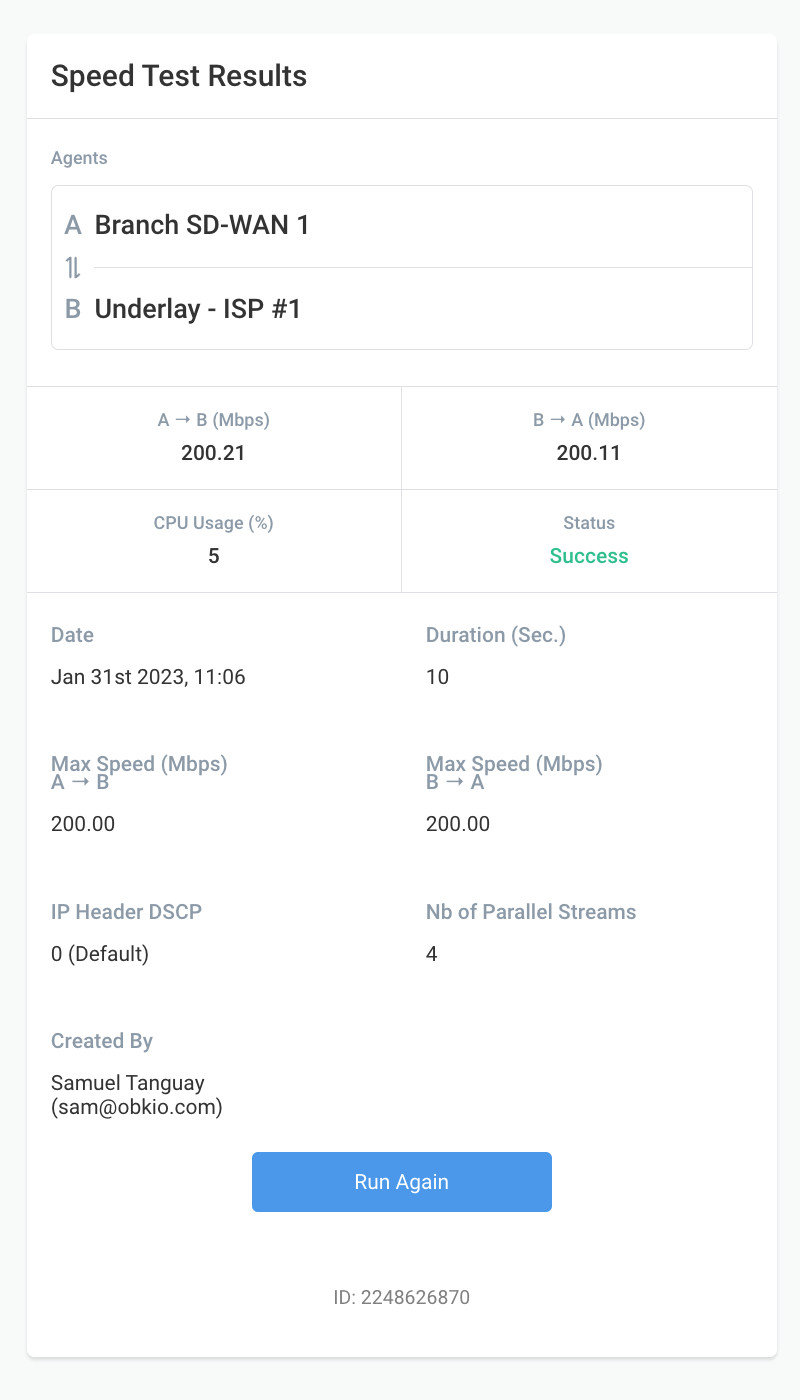
There is a common misconception that bandwidth can be used to measure network speed, but this is not entirely accurate. Despite this, Internet Service Providers often advertise high-speed services based on the maximum amount of available bandwidth.
While this may make for a good sales pitch, it’s not technically correct. Increasing the bandwidth only means that more data can be sent at once, which may make the network appear faster, but it does not affect the actual speed at which the packets are travelling.
In reality, the speed of a network is determined by a variety of factors, with network response time being a critical measure of speed within a network. Metrics like packet loss and latency can significantly impact network speed.
As we said earlier, when it comes to network performance, speed isn’t everything, quality matters too.
While bandwidth is a key factor in determining potential network speed, it’s only one piece of the puzzle. A well-balanced network with sufficient bandwidth, low latency, and minimal congestion ensures the best overall performance. High bandwidth affects speed because it allows for the potential of higher speeds, but it also depends on other factors.
1. Higher Bandwidth = Potential for Faster Speed: With more bandwidth, your network can handle larger amounts of data simultaneously, which typically results in faster downloads, uploads, and smoother streaming.
- Example: Upgrading from 100 Mbps to 500 Mbps allows more devices to use the network without slowing down individual performance.
2. Saturation Slows Speed: If your bandwidth is maxed out (too many users or high-demand applications like video streaming or gaming), your network speed will slow down. Think of a one-lane highway during rush hour—traffic jams slow everything to a crawl.
3. Bandwidth Doesn’t Solve Latency Issues: While bandwidth allows for more data flow, it doesn’t address delays caused by latency (the time it takes for a signal to travel between points).
- Example: A video call may lag even on a high-bandwidth network if latency is high due to distance or poor routing.
4. Over-Provisioning Won’t Always Increase Speed: If your current bandwidth exceeds your usage needs, adding more bandwidth won’t make your network faster.
Example: If your speed is limited by a slow server or poor Wi-Fi signal, more bandwidth won’t help.
Other Factors to Consider
- Congestion: Multiple devices or users can strain bandwidth, reducing available speed.
- Network Hardware: Outdated routers, switches, or cables may bottleneck speed even with high bandwidth.
- ISP Limitations: Some providers throttle speeds during peak hours regardless of bandwidth.
 Screenshot from Obkio's Network Performance Monitoring Tool
Screenshot from Obkio's Network Performance Monitoring Tool
Having plenty of bandwidth but experiencing slow speeds can be frustrating. This mismatch happens because bandwidth and speed aren’t the same thing.
If your bandwidth is fine but speed feels slow, it may be due to other network speed issues. Speed issues, despite sufficient bandwidth, are often caused by factors like latency, packet loss, congestion, or hardware limitations.
High Latency (The Delay Factor): Even with ample bandwidth, high latency can slow your speed. A video call may stutter if there’s a 300ms delay, even on a high-bandwidth connection.
Network Congestion (The Traffic Jam): Bandwidth is shared across all devices on your network. If multiple users or apps (like streaming, gaming, and downloads) are active, congestion occurs.
Packet Loss (The Data Leak): When packets (small chunks of data) are lost during transmission, they need to be resent, slowing down your effective speed. A 10% packet loss rate can drastically reduce usable speed, even if your bandwidth is fine.
Wi-Fi Issues (The Weak Link): If you’re connected wirelessly, weak signals, interference, or distance from the router can bottleneck your speed. A 500 Mbps Internet plan might only deliver 50 Mbps to your device on a weak Wi-Fi signal.
Server Limitations (The Bottleneck): The speed of a website, app, or service is often limited by its server. If the server is slow or far away, your speed will feel slow regardless of your bandwidth.
ISP Throttling (The Hidden Cap): Some Internet Service Providers (ISPs) throttle speeds for certain activities, like streaming or gaming, during peak hours.
Old or Overloaded Hardware (The Weak Link): Outdated routers, switches, or devices may not support your full bandwidth or could be overloaded. For example, a router capped at 100 Mbps won’t deliver the full speed of a 500 Mbps plan.
Unlock the secrets of Internet SLA monitoring, optimize your online experience, and hold your ISP accountable. Empower your Internet journey!
Learn more

Throughput and network speed are also related but different concepts.
To understand the difference between throughput and network speed, we’re going to use the water pipe analogy again. The water pipe is a network. Network speed is like the maximum flow rate of water that the pipe can handle.
Throughput is like the actual amount of water that flows through the pipe in a given period of time. The actual amount of water that flows through the pipe depends on various factors, including the pressure of the water, the diameter of the pipe, and any blockages or leaks in the pipe.
In summary, network speed refers to the theoretical maximum rate at which data can be transmitted over a network, while throughput refers to the actual rate at which data is transmitted over a network, taking into account real-world performance factors. Both concepts are important to understand and monitor for optimal network performance.

Throughput is often lower than bandwidth because of real-world factors that limit how much data is successfully transmitted and received over a network. While bandwidth refers to the maximum capacity of your connection, throughput measures the actual amount of data being transferred.
1. Network Congestion: When multiple devices or applications are using the network simultaneously, it creates congestion. This reduces the effective throughput as data packets compete for bandwidth.
2. Protocol Overheads: Every data packet includes additional information (headers, error-checking, etc.) for transmission, which takes up part of the bandwidth. This overhead reduces the space available for actual data, lowering throughput.
4. Distance and Signal Quality: In Wi-Fi networks, distance from the router or signal interference (e.g., from walls, other devices) can degrade throughput.
5. ISP Throttling: Some Internet Service Providers (ISPs) intentionally reduce throughput for certain activities or during peak usage times.
Throughput reflects the real-world efficiency of your network, while bandwidth is its theoretical maximum. Factors like congestion, latency, protocol overheads, and hardware bottlenecks explain why throughput is often lower than bandwidth. Addressing these factors will help you maximize your network’s potential.
Throughput and network capacity are also two related but distinct concepts often used in the context of computer networks, systems, and data transfer.
Throughput refers to the rate at which data is successfully transmitted or processed over a network, system, or component. It measures the actual amount of data that can be transferred or processed within a given timeframe.
- Measurements: Throughput is typically measured in bits per second (bps), kilobits per second (Kbps), megabits per second (Mbps), gigabits per second (Gbps), or bytes per second (Bps). It quantifies the speed of data transfer.
- Dynamic: Throughput can vary depending on network conditions, congestion, and the efficiency of protocols and devices. It represents the real-world performance of a system.
- Example: The download speed of your internet connection (e.g., 100 Mbps) is a measure of throughput. It tells you how quickly data can be downloaded.

Capacity, also known as bandwidth or capacity planning, refers to the maximum amount of data that a network, system, or component can theoretically handle under ideal conditions. It represents the upper limit or capability of a resource.
- Measurements: Capacity is also measured in bits per second (bps), Kbps, Mbps, Gbps, or Bps. It quantifies the potential maximum data transfer rate.
- Static: Capacity is a fixed measure and does not change with network conditions or usage. It is often determined by the design and specifications of network infrastructure.
- Example: A network link with a capacity of 1 Gbps can, in theory, transmit data at a rate of 1 gigabit per second under optimal circumstances.
Differences Between Throughput vs. Capacity:
- Dynamic vs. Static: Throughput is dynamic and reflects the actual performance experienced in real-world scenarios, accounting for factors like congestion and network conditions. Capacity is static and represents the maximum potential data transfer rate under ideal conditions.
- Real-World vs. Theoretical: Throughput measures real-world performance and is subject to fluctuations. Capacity is a theoretical maximum and is often used for planning and design purposes.
- Usage: Throughput is used to assess the current performance of a network or system. Network capacity is used for capacity planning, determining how much traffic a network can accommodate without exceeding its limits.
- Practicality vs. Potential: Throughput focuses on what can be achieved practically, considering existing conditions and constraints. Capacity represents the upper limit, which may not always be attainable in practice.
In summary, throughput measures the actual rate of data transfer or processing in real-world scenarios, while capacity defines the maximum potential data transfer rate under ideal conditions. Both concepts are essential for understanding and optimizing network and system performance, with throughput reflecting what users experience and capacity guiding network design and planning.
In many contexts, especially within networking, "capacity" and "bandwidth" are also often used interchangeably or closely related, but they do have nuanced differences:
- Definition: Capacity refers to the maximum amount of data that a network, system, or component can theoretically handle or support under ideal conditions.
- Static Measure: Capacity is typically a static measure and remains constant regardless of the actual usage or network conditions.
- Planning and Design: Capacity planning involves estimating the amount of resources needed to accommodate expected traffic or load on a network. It is crucial for determining the infrastructure's capabilities and ensuring it can handle future demand.
- Example: If a network link has a capacity of 1 Gbps (gigabit per second), it means the link can theoretically transmit data at a rate of 1 gigabit per second under ideal circumstances.
- Definition: Bandwidth, in the context of networking, generally refers to the data transmission rate of a network link, which is typically measured in bits per second (bps), kilobits per second (Kbps), megabits per second (Mbps), gigabits per second (Gbps), or similar units.
- Dynamic Measure: Bandwidth represents the actual data transfer rate of a network link or system in real-world scenarios. It can vary depending on factors such as network congestion and the number of active users.
- Real-Time Measure: Bandwidth is a dynamic, real-time measure of data transfer speed, and it reflects the current performance of a network link.
- Example: If you have an internet connection with a bandwidth of 100 Mbps, it means the current data transfer rate you can achieve on that connection is up to 100 megabits per second, but this rate can fluctuate depending on network conditions and usage.
While capacity and bandwidth are related concepts, they are not identical. Bandwidth typically represents the current data transfer rate or speed of a network link, while capacity refers to the maximum data transfer rate that the network, system, or component can theoretically support.
In practice, network capacity planning aims to ensure that the capacity of a network's various components (routers, switches, links) matches or exceeds the expected bandwidth requirements to maintain efficient network operation. So, while capacity and bandwidth are related, they serve different purposes in assessing and managing network performance and resources.
Now that we know that difference between network speed, bandwidth and throghuput, and we know why you should measure them, we have good news. You should measure them all and you can measure them all.
When we discussed the different methods for measuring these metrics, there was one tool in common for all of them: Network Performance Monitoring.
Many times when people look to monitor network speed, bandwidth or even throughput , they’ll just run a Speed Test using a speed test tool on a website. But doing that only tells you how fast your network is performing when you run that speed test, which isn’t super helpful when measuring performance.
That’s why we recommend using a tool like Obkio Network Performance Monitoring software, which continuously monitors:
- Performance metrics like network speed, bandwidth and throughput
- Quality metrics like jitter, packet loss, latency, and VoIP
- And network performance as a whole

Obkio monitors network metrics and network performance using synthetic UDP traffic and Network Monitoring Agents deployed in key network locations. Here’s what we recommend:
- Local Agents: Installed in the targeted office location experiencing connectivity issues. There are several Agent types available (all with the same features), and they can be installed on MacOS, Windows, Linux and more.
- Public Monitoring Agents: Which are deployed over the Internet and managed by Obkio. They compare performance up to the Internet and quickly identify if the problem is global or specific to the destination.
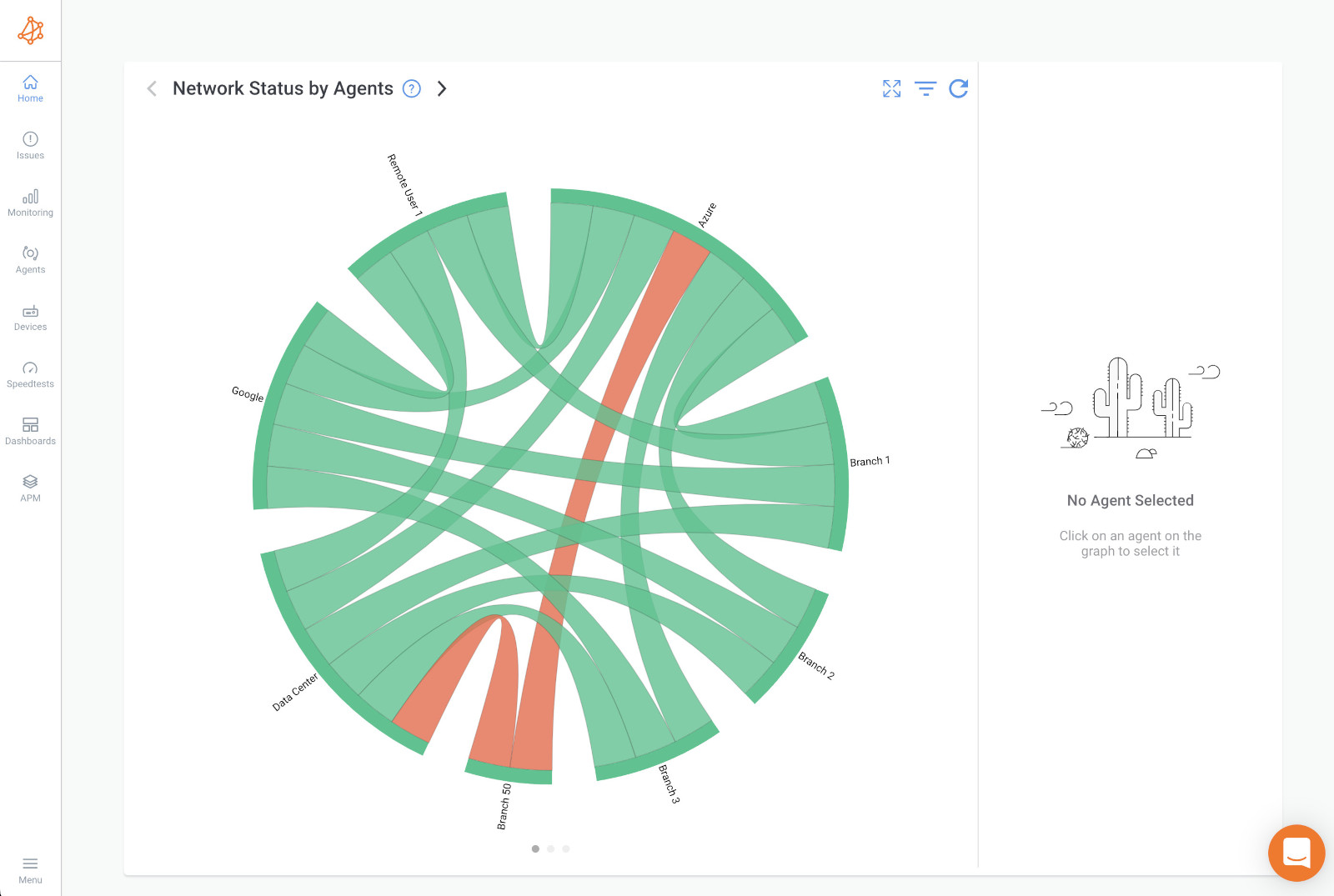
Once you’ve deployed Obkio Monitoring Agents in your key network locations, Obkio will start collecting performance data to identify network issues.
- Use Obkio to run speed tests between any monitoring agents deployed in your network.
- Use network device monitoring to monitor bandwidth and other resource metrics like CPU usage.
We’ve said it before and we’ll see it again: Speed isn’t everything. In a network, you may have fast Internet speed, but still experience a large amount of packet loss that will cause major issues with Internet performance.
That’s why Obkio monitors other network metrics to really understand the quality and performance of your network.
- Throughput
- Jitter
- Packet Loss
- Latency
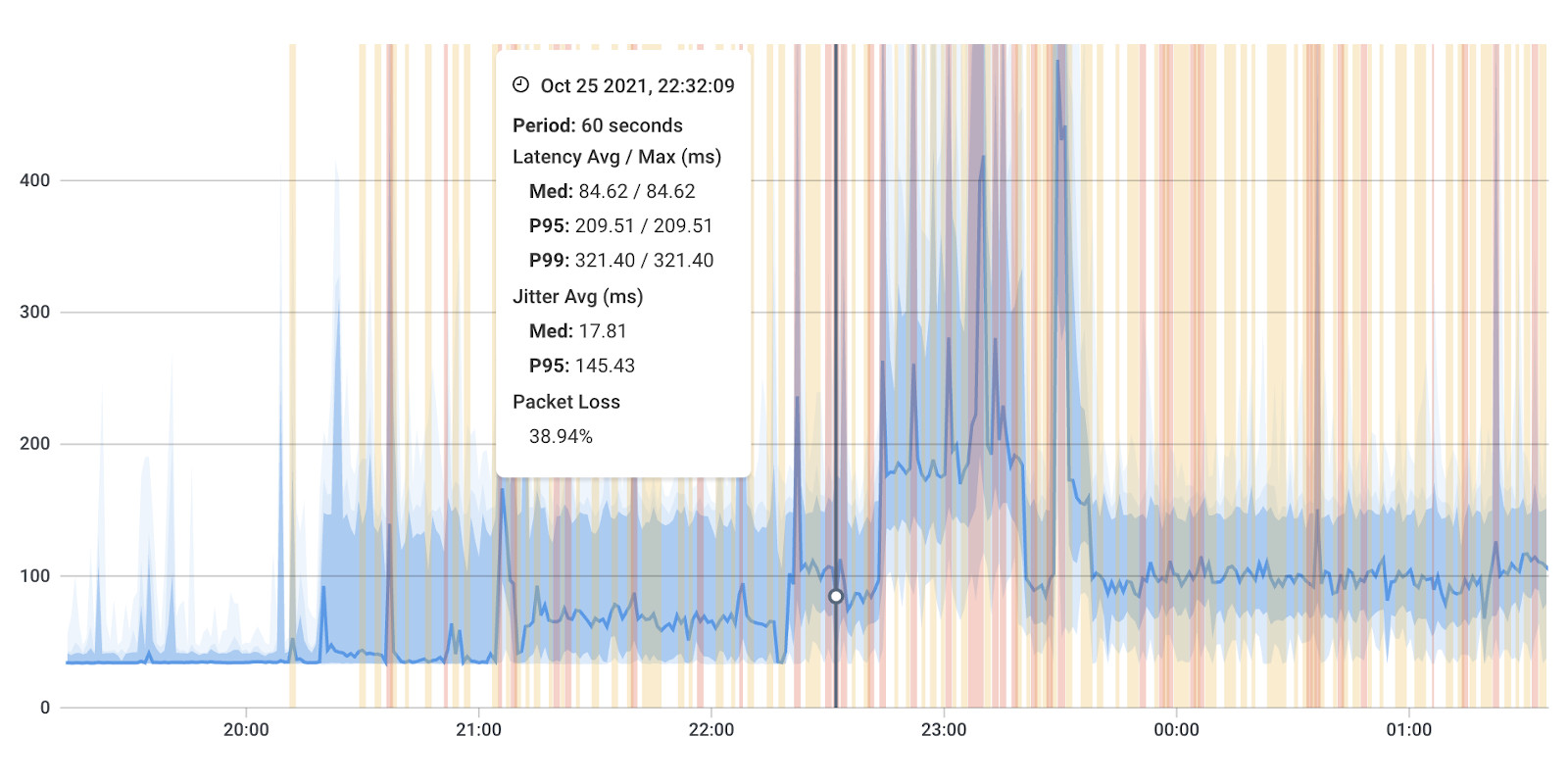
Besides speed and bandwidth, latency is also important to mention when talking about throughput. In a network, latency refers to the measure of time it takes for data to reach its destination across a network.
Latency not only affects the speed of data transmission but also the maximum throughput of data transmission. The reason for the impact of latency on throughput is due to the use of Transmission Control Protocol (TCP). TCP ensures that data packets reach their destination successfully and in the correct order. It also limits the amount of data that can be transmitted before waiting for an acknowledgement.
To better understand this relationship, consider a network path as a pipe filling a bucket with water. TCP requires that the sender waits for an acknowledgement to be received before sending more data once the bucket is full. If it takes half a second for the water to travel down the pipe and another half a second for the acknowledgement to return, the total latency is one second.
TCP would then limit the amount of data, or water in this example, that can be sent within a one-second period to prevent any data loss or errors.
When monitoring your network performance, measuring network throughput is a much better indicator of the quality of your network performance rather than bandwidth or speed.
Monitoring network throughput is particularly helpful when troubleshooting because it allows administrators to identify the underlying cause of a slow network. However, throughput alone is not sufficient to fully evaluate network performance. There are also other metrics you should consider that impact network performance.
- Latency, like we mentioned earlier, refers to the time it takes for a packet to travel from the source to its destination, and can be measured in various ways, such as network round-trip time or one-way data transfer.
- Packet loss refers to the number of packets lost during transmission. Packet loss happens when data packets being transmitted over a network (or between devices or across the Internet) get lost or dropped during transit and fail to reach their destination.
By measuring all three factors together, administrators can obtain a more comprehensive understanding of the network's performance.
Luckily, Obkio’s Network Performance Monitoring software will also help you measure latency and packet loss too!

Network speed, bandwidth, and throughput are all important metrics to measure, but they represent different aspects of network performance.Therefore, all three metrics are important to measure, but the most important one depends on the context and what you are trying to accomplish.
- If you want to measure the maximum capacity of a network, then network speed is the most important metric.
- If you want to measure the amount of data that can be transmitted over a network at any given time, then bandwidth is the most important metric.
- If you want to measure the actual performance of a network in real-world scenarios, then throughput is the most important metric.
In addition, measuring key network performance metrics like latency, packet loss and jitter will allow you to better understand if something is wrong with your network.
Don’t worry, you don’t have to do it alone. Obkio Network Performance Monitoring measures them all!



























 Obkio Blog
Obkio Blog






